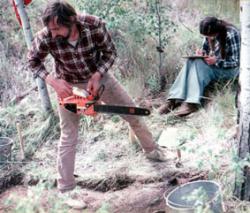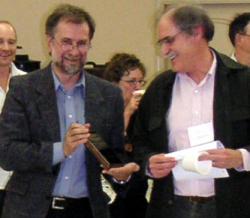

The CAA/ACA’s Smith-Wintemberg Award honours members of the Canadian archaeological community who have made an outstanding contribution to the advancement of the discipline of archaeology, or to our knowledge of the archaeological past of Canada. In recognition of R.G. Matson’s contributions to both of these areas, the Canadian Archaeological Association presented the Smith-Wintemberg Award to him on May 14, 2005, at the Annual Meeting in Nanaimo, British Columbia.
For over three decades, R.G. Matson has maintained a prolific research program, focusing on the archaeology of the Northwest Coast and the American Southwest. Matson received his BA (1966) from the University of California at Riverside, PhC (1969) and PhD (1971) from the University of California at Davis. His PhD research was on regional survey sampling and settlement patterns in the Cerbat Mountains of Northwestern Arizona on the periphery of the Great Basin. During his two years as a faculty member at Northern Arizona University from 1970-1972, Matson started his long-term research collaboration with Bill Lipe, and the two developed the Cedar Mesa project in Southeastern Utah.
Matson was appointed in the Department of Anthropology and Sociology at UBC in 1972, and soon started archaeological research in the Pacific Northwest. Over the next 32 years, until his retirement in July 2004, Matson conducted field research in both coastal (Gulf of Georgia) and interior (Chilcotin) regions of British Columbia-a research focus that he continues to this day. Throughout this time, Matson simultaneously maintained a very active research interest in US Southwest archaeology, and the Cedar Mesa, Utah region in particular. In addition to his regional interests, Matson was a pioneer in the use of regional sampling and subsistence-settlement studies, and quantitative methods in archaeological analysis. The account here emphasizes his contributions to Canadian archaeology.
R.G. Matson’s publication record started in 1970 with a co-authored article in Science presenting the use of numerical taxonomy methods for studying archaeological assemblages. Soon after his arrival at UBC, he applied this quantitative method to study inter-assemblage variability in the Gulf of Georgia region, publishing this study in Syesis in 1974, and his “clustering and scaling” approach became a hallmark of many subsequent studies conducted by him and his students.
R.G. Matson’s first field research in the Pacific Northwest involved excavations at the Glenrose Cannery site in 1973, and the resulting Mercury Series monograph (1976) identified a 8000 year long sequence of occupation in the Fraser delta that refined the culture history of the area, and provided the first detailed studies of subsistence and adaptive patterns for the Fraser Delta region. It is a “must read” site report for any student seriously interested in Northwest Coast Archaeology.
Matson subsequently turned his attention to the British Columbia Interior Plateau, conducting field research in 1974 on settlement patterns at the Chilcotin-Fraser River confluence. This was the first regional sampling survey and regional-level subsistence-settlement pattern research conducted in the plateau of western North America. He continued this Interior focus over the next decade. The Eagle Lake project involved four seasons of fieldwork (1979, 1983, 1984, and 1985), and focused on identifying Athapaskans in the archaeological record and dating the Athapaskan migration into the Chilcotin region, as well as conducting studies of Chilcotin ethnoarchaeology /upper elevation land use patterns. In this research, Matson developed the “Parallel Direct Historical Approach” method, carrying out two parallel investigations (at Mouth of Chilcotin and at Eagle Lake) to identify variation in the sequences that could be attributable to Athapaskan migration.
In the 1980s and throughout the 1990s, Matson initiated new field projects in the Gulf of Georgia region to study the development of the Northwest Coast ethnohistoric pattern. This coastal research focused on adaptive patterns of Northwest Coast people, the development of the stored salmon economy, the development of cultural complexity, and household archaeology. In addition to many small projects, he carried out major field excavations at the Beach Grove (1980) and Crescent Beach (1989-90) sites in the Fraser delta, and survey and excavations at the Shingle Point site on Valdes Island in the Gulf of Georgia in 1995-96.
R.G. Matson’s Coastal and Interior Plateau studies, as well as his US Southwest research, has resulted a continuous stream of publications over three decades, including: five authored or edited books (and one more accepted for publication), 11 peer review journal articles, 12 chapters in books, as well as numerous conference proceedings, encyclopedia entries, and book reviews. Journals include Science, American Antiquity, Journal of Field Archaeology, BC Studies, Syesis, Kiva, and Muse. Many of these publications, such as the monograph on the Glenrose excavations, are acknowledged as critical to the study of Northwest Coast archaeology. In addition to reporting on his specific research, Matson co-authored a major synthesis-Prehistory of the Northwest Coast-published in 1995 by Academic Press, that has become the major textbook for students studying the archaeology of the region. More recently, he co-edited Emerging from the Mist: Studies in Northwest Coast Culture History-a collection of papers presenting state of the art interdisciplinary research on pre-contact Northwest Coast societies.
During his career as a professor at UBC, Matson supervised over 15 graduate students to completion, and also served on the advisory committees of twice as many more students. He taught courses ranging from the flagship “Archaeology of BC” to introductory archaeology, analytical methods, and 10 archaeological field schools on the coast and interior. Throughout, he has shown a true devotion to the development of a strong archaeology presence at UBC. He has set and maintained high standards of excellence for his many students, many of whom have gone on to professional careers in the discipline. A true field archaeologist, he has tried to incorporate field components into his courses whenever possible, including the legendary Anthropology 420 weekend site tour,campout and clam bake (rain or shine!) in the Gulf Islands.
R.G. Matson served many terms as Director of the Laboratory of Archaeology at UBC, and was instrumental in developing it as a distinct subunit of the Department of Anthropology and Sociology. He also served three terms as Curator of Archaeology at the UBC Museum of Anthropology, where his contributions included the development of the permanent archaeology gallery, supervising temporary/travelling exhibits as well as public programming.
In summary, R.G. Matson has made enormous contributions to North American archaeology in general and Western Canadian archaeology in particular. Given this record of research and publication, R.G. Matson has established a reputation as a senior expert in Pacific North West archaeology. He has worked tirelessly over three decades to further our knowledge of the ancient cultures of the Pacific Northwest and the US Southwest. The CAA/ACA recognizes R.G. Matson’s significant achievements by presenting him with the Smith-Wintemberg Award.
David Pokotylo
Field photograph is of R.G. Matson and Diane Lulua at Eagle Lake in 1983.
Madonna Moss kindly allowed the use of the photo of R.G. Matson being presented with the Smith-Wintemberg Award by David Pokotylo in Nanaimo .
